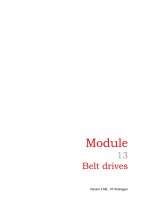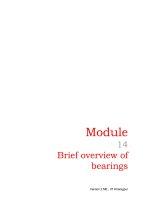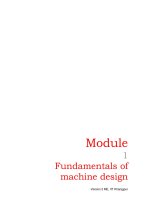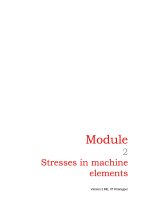Fundamentals of Machine Design P37
Bạn đang xem bản rút gọn của tài liệu. Xem và tải ngay bản đầy đủ của tài liệu tại đây (239.87 KB, 12 trang )
Module
13
Belt drives
Version 2 ME , IIT Kharagpur
Lesson
1
Introduction to Belt
drives
Version 2 ME , IIT Kharagpur
Instructional Objectives:
At the end of this lesson, the students should be able to understand:
• Uses and advantages of belt drives
• Types of belt drives and their nomenclature
• Relationship between belt tensions
• Some commonly used design parameters
13.1.1 Flexible Machine Elements
Belt drives are called flexible machine elements. Flexible machine elements are
used for a large number of industrial applications, some of them are as follows.
1. Used in conveying systems
Transportation of coal, mineral ores etc. over a long distance
2. Used for transmission of power.
Mainly used for running of various industrial appliances using prime movers
like electric motors, I.C. Engine etc.
3. Replacement of rigid type power transmission system.
A gear drive may be replaced by a belt transmission system
Flexible machine elements has got an inherent advantage that, it can absorb a
good amount of shock and vibration. It can take care of some degree of
misalignment between the driven and the driver machines and long distance
power transmission, in comparison to other transmission systems, is possible.
For all the above reasons flexible machine elements are widely used in industrial
application.
Although we have some other flexible drives like rope drive, roller chain drives
etc. we will only discuss about belt drives.
13.1.2 Typical belt drives
Two types of belt drives, an open belt drive, (Fig. 13.1.1) and a crossed belt drive
(Fig. 13.1.2) are shown. In both the drives, a belt is wrapped around the pulleys.
Let us consider the smaller pulley to be the driving pulley. This pulley will transmit
motion to the belt and the motion of the belt in turn will give a rotation to the
larger driven pulley. In open belt drive system the rotation of both the pulleys is in
the same direction, whereas, for crossed belt drive system, opposite direction of
rotation is observed.
Version 2 ME , IIT Kharagpur
13.1.3 Nomenclature of Open Belt Drive
d
L
- Diameter of the larger pulley
d
S
– Diameter of the smaller pulley
α
L
- Angle of wrap of the larger pulley
α
S
– Angle of wrap of the smaller pulley
L
C- Center distance between the two pulleys
Basic Formulae
α
L =
180
ο
+ 2β
α
S =
180
ο
- 2β
Where angle β is,
L
0
= Length of open belt
This formulae may be verified by simple geometry.
13.1.4 Nomenclature of Cross Belt Drive
d
L
- Diameter of the larger pulley
d
S
– Diameter of the smaller pulley
α
L
- Angle of wrap of the larger pulley
α
S
– Angle of wrap of the smaller pulley
C- Center distance between the two pulleys
α
S
α
C
β
d
s
d
L
Fig.13.1.1 Open belt drive
1
LS
dd
sin
2C
−
−
⎛⎞
β=
⎜⎟
⎝⎠
() ()
2
oLS L
1
Ldd2Cdd
24C
π
=+++ −
S
Fig. 13.1.2 Cross belt drive
L
α
S
α
β
C
d
s
d
L
Version 2 ME , IIT Kharagpur
Basic Formulae
α
L =
α
S
= 180
ο
+ 2β
Where angle β is,
1
LS
dd
sin
2C
−
−
⎛⎞
β=
⎜⎟
⎝⎠
Length of cross belt
() ()
2
cLS L
1
Ldd2Cdd
24C
π
=+++ +
S
13.1.5 Belt tensions
The belt drives primarily operate on the friction principle. i.e. the friction between
the belt and the pulley is responsible for transmitting power from one pulley to the
other. In other words the driving pulley will give a motion to the belt and the
motion of the belt will be transmitted to the driven pulley. Due to the presence of
friction between the pulley and the belt surfaces, tensions on both the sides of
the belt are not equal. So it is important that one has to identify the higher tension
side and the lower tension side, which is shown in Fig. 13.1.3.
Belt motion
Fig.13.1.3 Belt tensions
Driving pulley Driven pulley
Friction
on pulley
Friction
on belt
T
2
T
2
T
1
T
1
T
1
>T
2
When the driving pulley rotates (in this case, anti-clock wise), from the
fundamental concept of friction, we know that the belt will oppose the motion of
the pulley. Thereby, the friction, f on the belt will be opposite to the motion of the
pulley. Friction in the belt acts in the direction, as shown in Fig. 13.1.3, and will
impart a motion on the belt in the same direction. The friction f acts in the same
Version 2 ME , IIT Kharagpur









